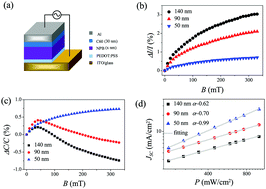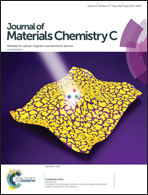Sign reversal of magneto-capacitance in an organic heterojunction based opto-spintronic system†
Abstract
Magneto-capacitance is a unique characteristic in organic semiconductors without involving ferromagnetism and ferroelectricity due to some purely spin-related dynamic processes. In this work, we report a remarkably magneto-capacitive effect (∼0.8%) in an organic opto-spintronic device comprising an NPB (N,N′-bis(naphthalene-1-yl)-N,N′-bis(phenyl)benzidine)/C60 heterojunction at excited states in ambient temperature. We have found that it is possible to achieve both positive and negative magneto-capacitance for such a device at different field strengths upon photo-excitation and ac-electric field modulation. Owing to the largely imbalanced charge carrier mobilities of NPB and C60; and, based on our theoretical fittings by the empirical Lorentzian formula, the effect can be attributed to the competition between the spin-dependent dissociation and bi-molecular recombination mechanisms at different field strengths under ac-frequency modulation and different illumination intensities. We believe a complete understanding of such an effect may shed a new light on the wide applications of the organic heterojunction based organic opto-spintronic system.



 Please wait while we load your content...
Please wait while we load your content...